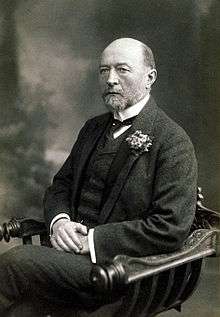Emil von Behring
| Emil von Behring | |
|---|---|
 Emil Adolf von Behring | |
| Born |
Adolf Emil Behring 15 March 1854 Hansdorf,Kreis Rosenberg Prussia (now Poland) |
| Died |
31 March 1917 (aged 63) Marburg, Hesse-Nassau |
| Nationality | German |
| Known for | Diphtheria antitoxin/serum |
| Awards | Nobel Prize in Physiology or Medicine (1901) |
| Scientific career | |
| Fields | Physiology, immunology |
| Notable students | Hans Schlossberger |
Emil von Behring (Emil Adolf von Behring), born as Emil Adolf Behring (15 March 1854 – 31 March 1917), was a German physiologist who received the 1901 Nobel Prize in Physiology or Medicine, the first one awarded, for his discovery of a diphtheria antitoxin. He was widely known as a "saviour of children," as diphtheria used to be a major cause of child death.[1] He was honored with Prussian nobility in 1901, henceforth being known by the surname "von Behring."
Biography
Behring was born in Hansdorf, Kreis Rosenberg, Province of Prussia (now Ławice, Iława County, Poland). His father was a schoolmaster; the family had 13 children.
Between 1874 and 1878, he studied medicine at the Kaiser-Wilhelm-Akademie in Berlin, an academy for military doctors, since his family could not afford the university.[2] As a military doctor, he studied the action of iodoform. In 1888, he became an assistant at the institute of Robert Koch in Berlin.
In 1890 he published an article with Kitasato Shibasaburo reporting that they had developed "antitoxins" against both diphtheria and tetanus. They had injected diphtheria and tetanus toxins into guinea-pigs, goats and horses; when these animals developed immunity, they derived antitoxins (now known to consists of antibodies) from their serum. These antitoxins could protect against and cure the diseases in non-immunized animals. In 1892 he started the first human trials of the diphtheria antitoxin, but they were unsuccessful. Successful treatment started in 1894, after the production and quantification of antitoxin had been optimized.[3]
In 1895 he became Professor of Hygienics within the Faculty of Medicine at the University of Marburg, a position he would hold for the rest of his life. He and the pharmacologist Hans Horst Meyer had their laboratories in the same building, and Behring stimulated Meyer's interest in the mode of action of tetanus toxin.[4]
Behring won the first Nobel Prize in Physiology or Medicine in 1901 for the development of serum therapies against diphtheria. He was elected a Foreign Honorary Member of the American Academy of Arts and Sciences in 1902.[5]
In 1904 he founded the Behringwerke in Marburg, a company to produced antitoxins and vaccines.
At the International Tuberculosis Congress in 1905 he announced that he had discovered "a substance proceeding from the virus of tuberculosis." This substance, which he designated "T C," plays the important part in the immunizing action of his "bovivaccine", which prevents bovine tuberculosis. He tried unsuccessfully to obtain a protective and therapeutic agents for humans.[6]
_-_Wannkopfstra%C3%9Fe_(1).jpg)
Behring died at Marburg, Hessen-Nassau, on 31 March 1917. His name survived in the Dade Behring organisation (now part of the Siemens Heathineers), in CSL Behring, a manufacturer of plasma-derived biotherapies, in Novartis Behring and in the Emil von Behring Prize of the University of Marburg, the highest endowed medicine award in Germany.
His Nobel Prize medal is now kept on display at the International Red Cross and Red Crescent Museum in Geneva.
Controversy
Von Behring is believed to have cheated Paul Ehrlich out of recognition and financial reward in relation to collaborative research in diphtheria. The two men developed a diphtheria serum by repeatedly injecting the deadly toxin into a horse. The serum was used effectively during an epidemic in Germany. A chemical company preparing to undertake commercial production and marketing of the diphtheria serum offered a contract to both men, but von Behring maneuvered to claim all the considerable financial rewards for himself. To add insult to injury, only Behring received the first Nobel Prize in Medicine, in 1901, for his contributions.[7]

.jpg)
Personal life
In December, 29th, 1896, Behring married the then twenty-year-old Else Spinola (1876-1936), who was a daughter of Bernhard Spinola, the director of the Charité hospital in Berlin, and a Jewish-born mother - Elise Spinola, born Bendix - who had converted to Christianity upon her marriage.[8] They had six sons. They held their honeymoon at villa "Behring" on Capri 1897, where Behring owned a vacation home. In 1909–1911, the Russian writer Maxim Gorky lived at this villa.
Publications
- Die Blutserumtherapie (1892)
- Die Geschichte der Diphtherie (1893)
- Bekämpfung der Infektionskrankheiten (1894)
- Beiträge zur experimentellen Therapie (1906)
- E. v. Behring's Gesammelte Abhandlungen (1915) Digital edition by the University and State Library Düsseldorf
See also
References
- ↑ The Immune System: In Defence of our Lives, nobelprize.org
- ↑ "Emil von Behring - Biographical". www.nobelprize.org. Retrieved 2018-07-23.
- ↑ Kaufmann, Stefan H. E. (2017-03-08). "Remembering Emil von Behring: from Tetanus Treatment to Antibody Cooperation with Phagocytes". mBio. 8 (1): e00117–17. PMID 28246359.
- ↑ Legrum, Wolfgang; Al-Toma, Adnan J.; Netter, Karl J. (1992). 125 Jahre Pharmakologisches Institut der Philipps-Universität Marburg. Marburg: N. G. Elwert Verlag. ISBN 3770809858.
- ↑ "Book of Members, 1780–2010: Chapter B" (PDF). American Academy of Arts and Sciences. Retrieved 30 May 2011.
- ↑ Emil von Behring Serum Therapy in Therapeutics and Medical Science. Nobel Lecture, December 12, 1901. nobelprize.org
- ↑ Morton A. Meyers, M.D. (2007). Happy Accidents: Serendipity in Modern Medical Breakthroughs.
- ↑ Derek S. Linton, Emil von Behring: Infectious Disease, Immunology, Serum Therapy, American Philosophical Society, 2005, p. 198
- Kornelia Grundmann (3 December 2001). "Emil von Behring: The founder of serum therapy". The Nobel Foundation. Retrieved 2008-07-21.

- Ulrike Enke: Salvatore dell'Infanzia Behring and Capri
- Christoph Hans Gerhard : Trias deutschen Forschergeistes Emil von Behring Pflaum-Verlag / Munich Naturheilpraxis 71.Jahrgang January, 2018
External links
- www.uni-marburg.de/behring-digital
- Newspaper clippings about Emil von Behring in the 20th Century Press Archives of the German National Library of Economics (ZBW)
| Wikimedia Commons has media related to Emil Adolf von Behring. |